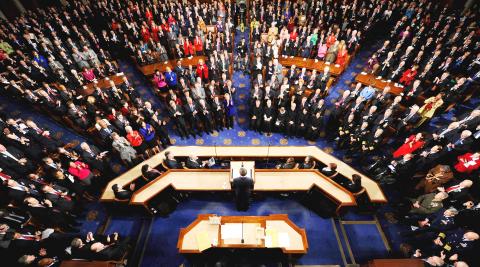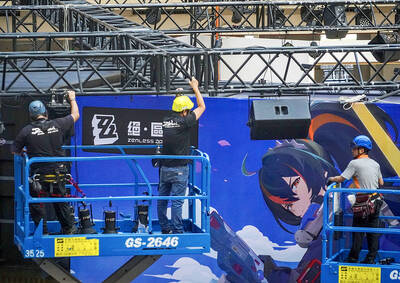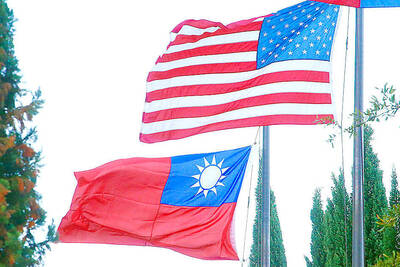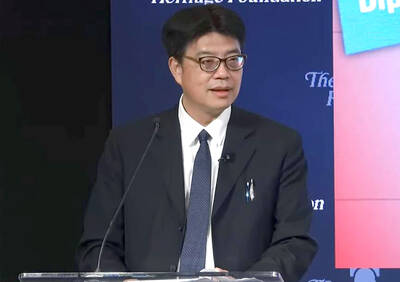US President Barack Obama gave Americans a sign of how he’ll lead the country in the run up to next year’s election, as he used his State of the Union address to stake out ground in the political center and call on Republicans and Democrats to work together to revive the US economy.
The nationally televised speech on Tuesday night was Obama’s first appearance before Congress since opposition Republicans took control of the House of Representatives earlier this month. It marked the midpoint of his presidential term, as he rebounds from the Democrats’ electoral defeat in November. The speech also came as he begins positioning himself for next year’s re-election campaign.
Obama kept the focus on the economy, calling for both parties to unite behind his program of cuts and spending, saying: “We will move forward together or not at all.”

PHOTO: AFP
He proposed no major initiatives comparable to the health care overhaul that dominated the first two years of his presidency, instead outlining an agenda aimed at both ends of the political spectrum.
For Democrats, he defended his health care plan, opposed privatization of the Social Security pension program and called for ending tax cuts for the rich. He also proposed a burst of spending on education, research, technology and transportation to make the US more competitive with emerging economic powers like China and India.
However, Obama also backed some top priorities of Republicans. He called for freezing some federal spending, cutting the corporate tax rate, shaking up the federal government and eliminating lawmakers’ pet projects.
Though Obama won some cheers from Republicans, they remain dissatisfied with his efforts to cut the deficit, their core issue.
House Budget Committee Chairman Paul Ryan, giving the official Republican response, said the US was at “a tipping point” leading to a dire future if federal deficits aren’t trimmed.
Obama spoke to a television audience in the millions and a Congress sobered by the assassination attempt against one if its own members, Gabrielle Giffords. She was seriously wounded in the shooting rampage in Tucson, Arizona, that killed six people. Her seat sat empty.
Obama entered the House chamber to prolonged applause, and to the unusual sight of Republicans and Democrats seated next to one another rather than on different sides of the center aisle, in a show of support and civility following Giffords’ shooting. And he began on a graceful note, taking a moment to congratulate John Boehner, the new Republican speaker of the House.
Calling for a new day of cooperation, Obama said: “What comes of this moment will be determined not by whether we can sit together tonight but whether we can work together tomorrow.”
In a speech with little focus on national security, Obama appeared to close the door on keeping any significant US military presence in Iraq beyond the end of the year.
“This year, our civilians will forge a lasting partnership with the Iraqi people while we finish the job of bringing our troops out of Iraq,” he said.
The president reiterated his call for a comprehensive immigration bill, although there appears little appetite for it in Congress.

Taiwan is projected to lose a working-age population of about 6.67 million people in two waves of retirement in the coming years, as the nation confronts accelerating demographic decline and a shortage of younger workers to take their place, the Ministry of the Interior said. Taiwan experienced its largest baby boom between 1958 and 1966, when the population grew by 3.78 million, followed by a second surge of 2.89 million between 1976 and 1982, ministry data showed. In 2023, the first of those baby boom generations — those born in the late 1950s and early 1960s — began to enter retirement, triggering

ECONOMIC BOOST: Should the more than 23 million people eligible for the NT$10,000 handouts spend them the same way as in 2023, GDP could rise 0.5 percent, an official said Universal cash handouts of NT$10,000 (US$330) are to be disbursed late next month at the earliest — including to permanent residents and foreign residents married to Taiwanese — pending legislative approval, the Ministry of Finance said yesterday. The Executive Yuan yesterday approved the Special Act for Strengthening Economic, Social and National Security Resilience in Response to International Circumstances (因應國際情勢強化經濟社會及民生國安韌性特別條例). The NT$550 billion special budget includes NT$236 billion for the cash handouts, plus an additional NT$20 billion set aside as reserve funds, expected to be used to support industries. Handouts might begin one month after the bill is promulgated and would be completed within

NO CHANGE: The TRA makes clear that the US does not consider the status of Taiwan to have been determined by WWII-era documents, a former AIT deputy director said The American Institute in Taiwan’s (AIT) comments that World War-II era documents do not determine Taiwan’s political status accurately conveyed the US’ stance, the US Department of State said. An AIT spokesperson on Saturday said that a Chinese official mischaracterized World War II-era documents as stating that Taiwan was ceded to the China. The remarks from the US’ de facto embassy in Taiwan drew criticism from the Ma Ying-jeou Foundation, whose director said the comments put Taiwan in danger. The Chinese-language United Daily News yesterday reported that a US State Department spokesperson confirmed the AIT’s position. They added that the US would continue to

IMPORTANT BACKER: China seeks to expel US influence from the Indo-Pacific region and supplant Washington as the global leader, MAC Minister Chiu Chui-cheng said China is preparing for war to seize Taiwan, Mainland Affairs Council (MAC) Minister Chiu Chui-cheng (邱垂正) said in Washington on Friday, warning that Taiwan’s fall would trigger a regional “domino effect” endangering US security. In a speech titled “Maintaining the Peaceful and Stable Status Quo Across the Taiwan Strait is in Line with the Shared Interests of Taiwan and the United States,” Chiu said Taiwan’s strategic importance is “closely tied” to US interests. Geopolitically, Taiwan sits in a “core position” in the first island chain — an arc stretching from Japan, through Taiwan and the Philippines, to Borneo, which is shared by